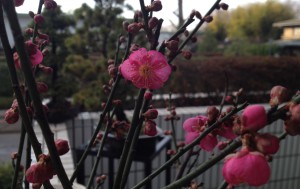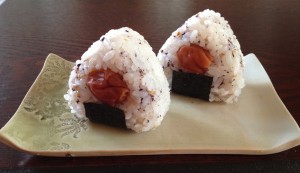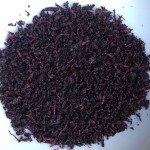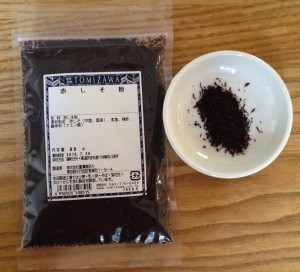It was way too warm in Tokyo the past weeks, it felt more like spring and I must admit that I was tempted to decorate my home with the first tulips in happy anticipation of spring. Already two weeks ago I also saw the first mountain vegetables for sale that usually come to market middle of February.

Very odd. But to straighten the seasons winter has kicked in this week and almost suppressed all the happy spring feelings. Almost, but not quite, as this morning I saw the first fully open plum blossom in my garden. I know that plum trees are supposed to bloom when there is still snow on the branches, but nevertheless for me they are a sign that spring is not very far away anymore.
Celebrating this finding I spontaneously decided to make my girls umé boshi onigigi (hand pressed rice balls with pickled plum) for their lunchbox today.

I mixed warm rice (thanks to the programming function of my rice cooker) with freshly roasted white sesame seeds and yukari, which are the red shiso leaves that are dried and pulverized after they have been used in the pickling of umé boshi (pickled plums)*. They are utterly delicious and have a subtle sour and salty plum flavor. My girls are addicted to onigiri with yukari and my oldest one even insisted to shape her own onigiri this morning. She lately enjoys to eat the umé boshi as well, even though they can be quite sour, so we added a little bit of it in the center.

Yukari is especially wonderful when packing onigiri in a bento box to enjoy later, as the containing salt preserves the rice from going bad. Not that this would be an issue with todays temperatures, but when the weather gets warmer and picnics become more popular it is a good thing to do.
A word of caution though. Most of the Yukari that is sold in ordinary supermarkets in Japan contains a lot of questionable ingredients, including Monosodium Glutamate or short MSG. If you are a Japan resident or travel to Japan have a look at a store called Tomizawa.

Tomizawa sells Yukari without MSG (as well as other types of Furikake – dry rice seasoning). In Tokyo they have shops throughout the city, including Shinjuku Keio, Yurakucho Lumine, Futakotamagawa and Shibuya Seibu. It is a wonderful place to shop for high quality Kambutsu (dried products) and bakery ingredients. Nowadays they label their products bilingual in Japanese and English, so you shouldn’t encounter problems finding what you are looking for. And it enables you to stroll around their store and discover wonderful new products you might have not known before (like e.g. amazingly purple sweet mashed potato flakes – great if you have guests). I usually leave the store with more than what I had planned, but the good news is that we are talking about Kambutsu, which by nature have a very long shelf life, so I know that at some point I will find a good use for whatever I purchase.
_______________________________
* “Nothing goes to waste in the Japanese kitchen”. For me this is one oft the most important mantras in Japanese Cooking. It is simply amazing how resourceful the Japanese are when preparing their food. Starting with the resources they need for cooking to using an ingredient fully, with many ingredients having more than one use. But discussing this goes beyond the scope of this article and I will write about it in more detail in a separate post. Sign up for the newsletter if you haven’t already and you won’t miss it.
4 thoughts on “Plums not Tulips”
Comments are closed.